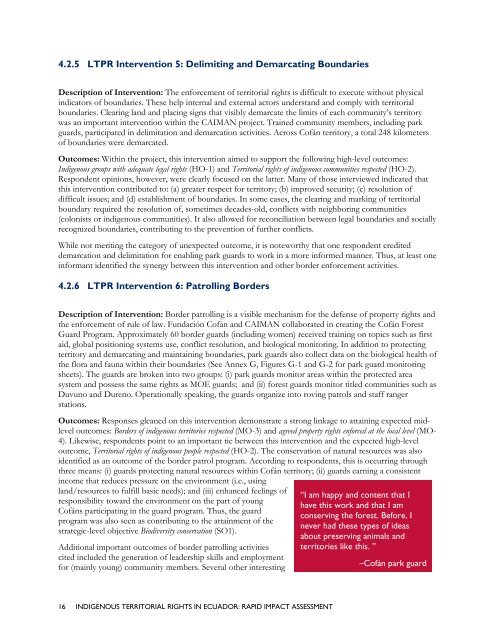ECUADOR - Land Tenure and Property Rights Portal
ECUADOR - Land Tenure and Property Rights Portal
ECUADOR - Land Tenure and Property Rights Portal
- No tags were found...
You also want an ePaper? Increase the reach of your titles
YUMPU automatically turns print PDFs into web optimized ePapers that Google loves.
4.2.5 LTPR Intervention 5: Delimiting <strong>and</strong> Demarcating BoundariesDescription of Intervention: The enforcement of territorial rights is difficult to execute without physicalindicators of boundaries. These help internal <strong>and</strong> external actors underst<strong>and</strong> <strong>and</strong> comply with territorialboundaries. Clearing l<strong>and</strong> <strong>and</strong> placing signs that visibly demarcate the limits of each community’s territorywas an important intervention within the CAIMAN project. Trained community members, including parkguards, participated in delimitation <strong>and</strong> demarcation activities. Across Cofán territory, a total 248 kilometersof boundaries were demarcated.Outcomes: Within the project, this intervention aimed to support the following high-level outcomes:Indigenous groups with adequate legal rights (HO-1) <strong>and</strong> Territorial rights of indigenous communities respected (HO-2).Respondent opinions, however, were clearly focused on the latter. Many of those interviewed indicated thatthis intervention contributed to: (a) greater respect for territory; (b) improved security; (c) resolution ofdifficult issues; <strong>and</strong> (d) establishment of boundaries. In some cases, the clearing <strong>and</strong> marking of territorialboundary required the resolution of, sometimes decades-old, conflicts with neighboring communities(colonists or indigenous communities). It also allowed for reconciliation between legal boundaries <strong>and</strong> sociallyrecognized boundaries, contributing to the prevention of further conflicts.While not meriting the category of unexpected outcome, it is noteworthy that one respondent crediteddemarcation <strong>and</strong> delimitation for enabling park guards to work in a more informed manner. Thus, at least oneinformant identified the synergy between this intervention <strong>and</strong> other border enforcement activities.4.2.6 LTPR Intervention 6: Patrolling BordersDescription of Intervention: Border patrolling is a visible mechanism for the defense of property rights <strong>and</strong>the enforcement of rule of law. Fundación Cofán <strong>and</strong> CAIMAN collaborated in creating the Cofán ForestGuard Program. Approximately 60 border guards (including women) received training on topics such as firstaid, global positioning systems use, conflict resolution, <strong>and</strong> biological monitoring. In addition to protectingterritory <strong>and</strong> demarcating <strong>and</strong> maintaining boundaries, park guards also collect data on the biological health ofthe flora <strong>and</strong> fauna within their boundaries (See Annex G, Figures G-1 <strong>and</strong> G-2 for park guard monitoringsheets). The guards are broken into two groups: (i) park guards monitor areas within the protected areasystem <strong>and</strong> possess the same rights as MOE guards; <strong>and</strong> (ii) forest guards monitor titled communities such asDuvuno <strong>and</strong> Dureno. Operationally speaking, the guards organize into roving patrols <strong>and</strong> staff rangerstations.Outcomes: Responses gleaned on this intervention demonstrate a strong linkage to attaining expected midleveloutcomes: Borders of indigenous territories respected (MO-3) <strong>and</strong> agreed property rights enforced at the local level (MO-4). Likewise, respondents point to an important tie between this intervention <strong>and</strong> the expected high-leveloutcome, Territorial rights of indigenous people respected (HO-2). The conservation of natural resources was alsoidentified as an outcome of the border patrol program. According to respondents, this is occurring throughthree means: (i) guards protecting natural resources within Cofán territory; (ii) guards earning a consistentincome that reduces pressure on the environment (i.e., usingl<strong>and</strong>/resources to fulfill basic needs); <strong>and</strong> (iii) enhanced feelings ofresponsibility toward the environment on the part of youngCofáns participating in the guard program. Thus, the guardprogram was also seen as contributing to the attainment of thestrategic-level objective Biodiversity conservation (SO1).Additional important outcomes of border patrolling activitiescited included the generation of leadership skills <strong>and</strong> employmentfor (mainly young) community members. Several other interesting“I am happy <strong>and</strong> content that Ihave this work <strong>and</strong> that I amconserving the forest. Before, Inever had these types of ideasabout preserving animals <strong>and</strong>territories like this. ”–Cofán park guard16 INDIGENOUS TERRITORIAL RIGHTS IN <strong>ECUADOR</strong>: RAPID IMPACT ASSESSMENT
















